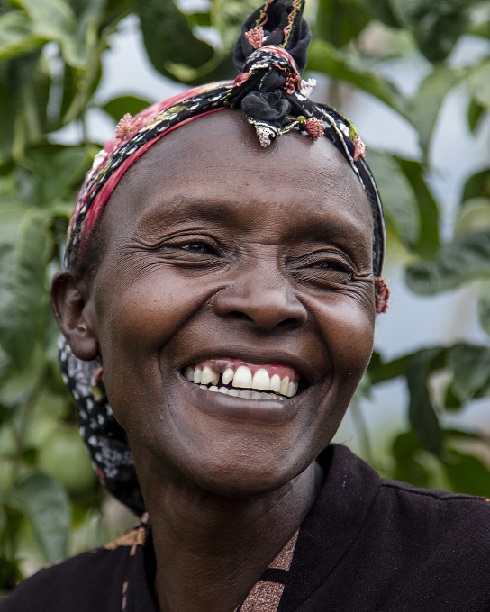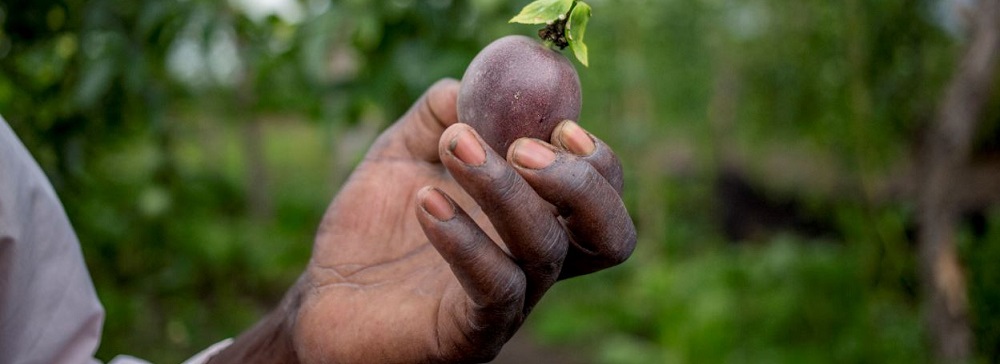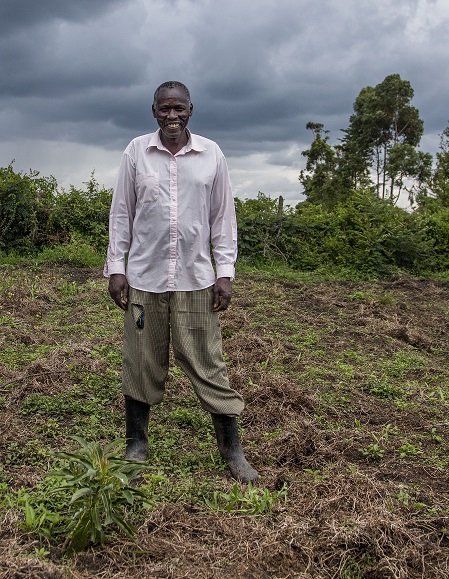
Meet Richard and Jane: the farmers transforming Kenya
“It’s not much to look at yet,” says Richard Langat, gesturing operatically at an empty dirt field, a twinkle of insane pride in his eyes. “But it will be.”
The 54-year-old farmer and Hand in Hand member has arrived at the edge of his smallholding, a quarter-acre of gently sloping countryside in Bomet County, Kenya, five hours west of Nairobi by SUV on roads so bumpy the four-wheel drive might as well have four legs. He’s been expounding on plants for the better part of an hour.
“All this one needs is a bit of pruning.” “Those? Those are soya beans.” “Insects, birds – they can’t resist capsicums [bell peppers]. That’s why I only grow a few: as a decoy to distract pests from my real crops.”
It’s an encyclopaedic display, one elevated to the miraculous by Richard’s apparent ability to forego breathing completely. But for all the activity on his buzzing farm, it’s this empty field, populated by a lone, straggly seedling not quite as tall as Richard’s old wellies, that’s caught the attention of neighbours and put Richard at the centre of not just his small rural community, but of Hand in Hand’s push to help more than 40,000 farmers stand up to climate change and move from subsistence to success. Far more notable than soya beans and decoy peppers is what’s not here: maize.
Bomet County, Kenya
Out with the old
If you’re in Kenya and you’re eating, you’re eating ugali. Made by boiling maize flour and, if you’ve got the money, enjoyed alongside meat or fish, this stodgy staple with a texture somewhere between polenta and drying cement is less the national dish than a central fact of existence. For millions of subsistence farmers, it’s the only meal they’ll eat all day.
Introduced by the Portuguese in the 17th and 18th centuries, then grown for export under British occupation in the 19th and 20th, the crop shot to ubiquity after colonial landowners discovered it also served a domestic purpose: cheap fuel for farm labourers. To consider the history of maize, in other words, is to consider the history of Kenya itself. But if maize has shaped the country’s past, it cannot shape its future, say experts. Famously vulnerable to ‘climate variability’ – droughts, floods, the vicissitudes of climate change – the crop is putting Kenya’s food security at risk, even while dooming millions of farmers like Richard to a cycle of deepening poverty.
“Since I’ve been here I’ve been trying to make money out of this farm, but I couldn’t,” he says. “When we invest KES 10,000 (US $100) in maize and come away with KES 3,000 (US $30) it’s not even enough to feed our family. We’re really making a big loss.”
For Richard, as for his neighbours, the solution is clear: stop growing maize and start growing something else. That’s easier said than done. Asking most Kenyans to stop growing maize is like asking a Kansan to stop growing wheat, or a shepherd in north Wales to abandon his flock.
Richard isn’t most Kenyans.
Beside every good man

Jane, 47.
Richard met Jane at a funeral. It was love at first sight.
Twenty-six years later the married couple still finish each other’s sentences, still audibly thrum when the other comes near. Richard likes to talk politics. Jane prefers to talk church. But get them going on any of their five children or the farm they’ve built up over the years and the two sing in perfect harmony.
“Before I was given this farm by my parents, the land was really exhausted,” says Jane, 47. “None of my brothers even wanted it, but you can see that it’s fertile now.”
Adds Richard: “The infrastructure around here still needs work, though. Give us roads, give us water – we’ll take care of the rest.”
Throughout Kenya, it’s a similar story. More than a third of the country’s 45 million people can’t afford to meet their basic needs, including food, clothing and shelter, according to research from Kenya’s Egerton University. Fourteen million can’t meet their daily food requirements. And 4 million couldn’t meet their daily caloric requirements if they spent their entire incomes on food. Almost all of these people are rural.
To transform their land from barren to fecund, the Langats have had to take risks and be enterprising. So when Hand in Hand arrived in Bomet County in the summer of 2017 offering a new crop – and new hope for a prosperous future – they jumped at the chance.
In with the new
Question: how do you to convince a community of farmers to abandon centuries of tradition and stop growing the crop they’ve survived off their whole lives?
Answer: you don’t.
Instead, you convince one of them, providing an entirely new crop that’s been selected for profitability and bred to withstand climate shocks like flooding and drought. Next, you throw in a university-trained agronomist to provide expert support. Then you step back and let the results – and the profits – speak for themselves.
So it was when Hand in Hand arrived on the Langats’ farm one sweltering day in the summer of 2017, carrying a basket of curiously tart fruit.
“I wasn’t familiar with passion fruit,” says Richard, holding out what looks like a plum. “Hand in Hand opened our minds. The training was simple and the crop doesn’t need too much attention, but it’s had a really big impact.”
“Big” is an understatement. In less than a year, the Langats went from losing KES 7,000 (US $70) harvesting maize to making KES 15,000 (US $150) each week growing passion fruit. Their neighbours, it will come as no surprise, have been keen to learn more. “Now that they’re seeing it, everybody’s doing it,” says Richard. “So far only two of us are harvesting. Then there are a number who are planting and others who are preparing to plant.”

Richard holds out a passion fruit.
Hand in Hand will be there for each and every one of them, first by propagating the crop using cuttings from Richard’s original, then by providing training on its upkeep and care using the Langats’ plot as our ‘demo farm’. Next year, when they’re ready, we’ll help the community form a producer’s group to negotiate with wholesalers, launching their produce into bigger markets and value chains. And we’re not stopping there.
Throughout Kenya, with generous support from the IKEA Foundation, our model is also propagating, reaching thousands of communities one Richard at a time. By the time we’re one, we’ll have helped more than 43,000 smallholder farmers boost their incomes while standing up to climate change with diversified, resilient crops. The money they earn will reverberate far beyond their smallholdings.
“I’ve got a boy in secondary school, a daughter in university studying French, and another studying computers at the Technical University of Mombasa,” says Richard. “With the money I earn, I’m paying the fees.”
Jane puts it more simply. “Now that we grow passion fruit instead of maize, we can buy our daily meals – not grow them. And when the children come home to visit, they can keep some money. I feel very happy, very loved. It’s a special feeling to know I can give them some money.”
And with the even newer

Richard, 54, his avocado plant and his empty field.
Back to the empty field, and Richard’s lone, straggly plant.
“This is hass avocado,” he says. “I got it from Hand in Hand.”
Kenya’s avocado exports have increased eight-fold since the turn of the century. Last year alone, prices doubled. A byword for Western hipsters, the nutrient-rich fruit is growing in popularity domestically, too. And Richard, and his neighbours, are soon to cash in.
Three years from now, this field and the farms surrounding it will support hundreds of fruit-bearing trees, the Langat’s plot again acting as demo farm, with Hand in Hand again providing support. Even if prices stall, each tree will be worth US $100 a year.
“You can see the way that I’m happy. I didn’t think it would be possible, I didn’t believe. I don’t even know if this is reality or a dream, because happiness comes for me if I just have a small-small profit from my crop,” says Richard, crouching down to get closer.
It’s not much to look at yet. But it will be.
By the numbers
KES 7,000 (US $70) loss growing maize during last harvest
KES 15,000 (US $150) per week growing passion fruit
Putting children through school and university
Next case study: Meet Gloria, the former refugee growing crops – and profits
